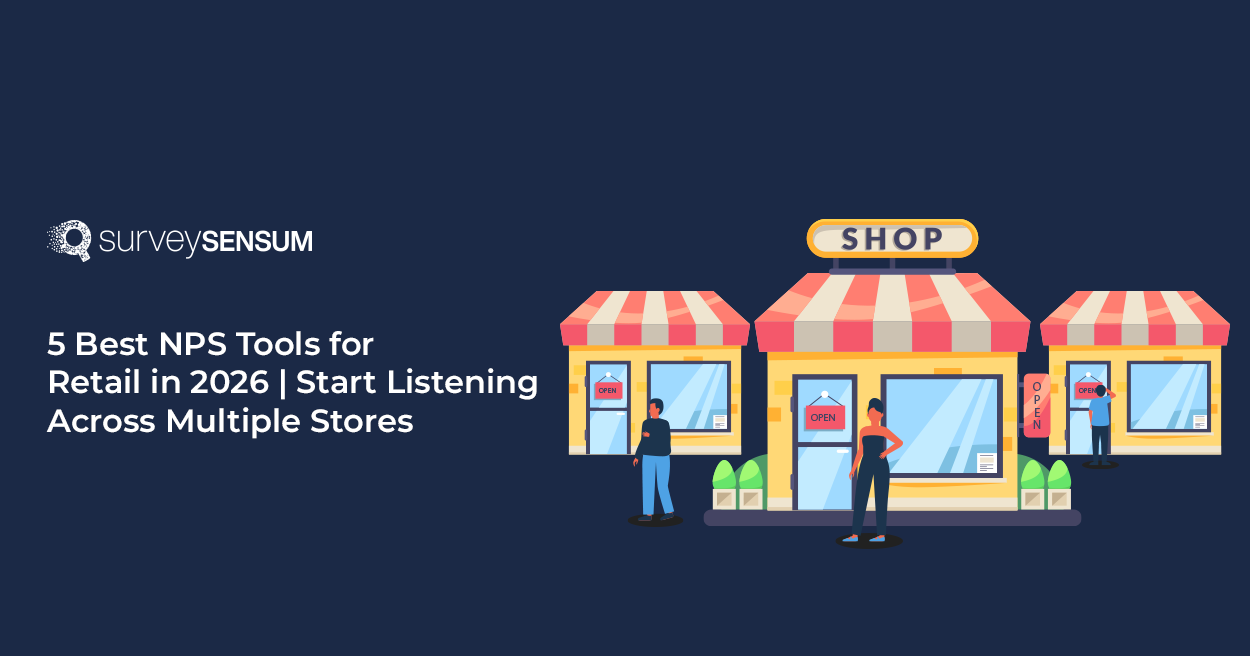

Delighted vs SurveyMonkey vs SurveySensum: Detailed Comparison
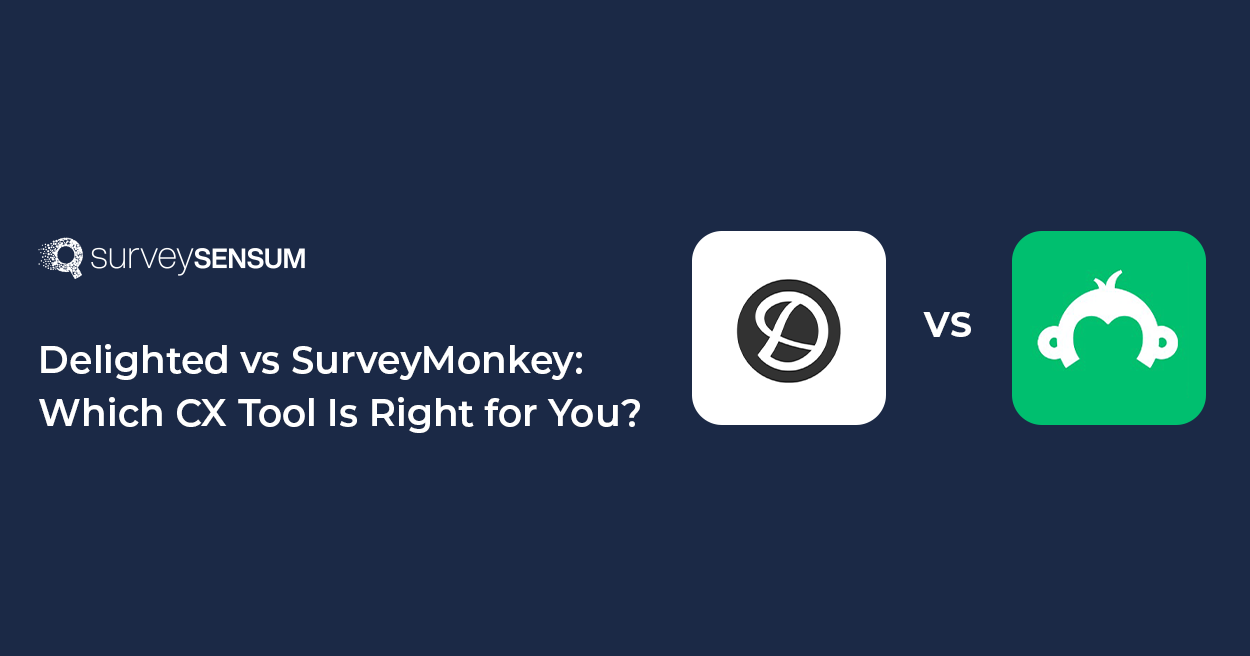
Did you hear? Delighted is officially sunsetting in 2026.
Already thinking, “What’s next?” You’re not alone, many teams are actively exploring alternatives to keep their CX programs running smoothly.
SurveyMonkey might seem like the next logical step, and yes, it’s powerful.
But here’s the catch: the UI can be clunky, customization is limited, and reporting lacks the depth modern teams need to make fast, confident decisions.
So what’s the smarter move?
SurveySensum — built for speed, simplicity, and insight.
With effortless Delighted data import, AI-powered feedback analysis, customizable dashboards, and real-time alerts, it’s everything you need to elevate your CX, without the learning curve.
Make the switch today. Stay ahead, not stuck.
Let’s start with Delighted.
What is Delighted?
Delighted is known for its simplicity. If you’re looking for a no-frills, NPS-focused solution to capture quick customer feedback, this tool might be for you.
It’s designed to get you up and running fast; you pick your survey type (primarily NPS), choose your distribution channel, and start collecting responses. No messy setups. No endless configurations.
Delighted Pricing
- Free plan available with basic features.
- The survey plans start at $17/month.
- Premium plans start at $224/month (billed annually).
Pros:
- Super easy to set up
- Clean UI with minimal learning curve
- Good for single-metric surveys like NPS
Cons:
- Limited to just a few survey types
- Lacks advanced reporting and analytics
- No real-time ticketing system
- No AI-powered insights or open-ended summaries
Now let’s move on to the veteran in the space – SurveyMonkey.
What is SurveyMonkey?
SurveyMonkey has been in the game for a long time — and it shows.
It’s packed with features for research professionals and power users. Want to create a 10-question product-market fit survey with advanced logic, piping, and randomized answer options? You can do that.
Want to send a simple NPS survey? Sure but it might take more time than expected.
SurveyMonkey Pricing
- Basic plan starts at $39/month per user
- Advanced features (e.g. logic branching, white-labeling, analytics) require premium plans, which starts at $139/month.
- Pricing gets steep quickly for large teams or long-term projects
Pros:
- Extremely customizable survey builder
- A wide range of templates and question types
- Integrates with 100+ tools (Salesforce, HubSpot, etc.)
- Great for academic and market research
Cons:
- Overwhelming for simple CX use cases
- Not built for real-time customer support follow-ups
- No native AI for insights or summarization
- Lacks built-in expert support or CX consultancy
So if Delighted is too light and SurveyMonkey feels too heavy… is there a smarter middle ground?
Yes. Meet SurveySensum.
What is SurveySensum?
Where Delighted feels too limited and SurveyMonkey feels overwhelming, SurveySensum strikes the perfect balance.
It’s built from the ground up for CX teams, especially those who want more than just data collection.
It helps you create multi-touchpoint surveys, gather real-time insights, close the loop, and get expert support every step of the way. Plus, it comes with AI features that simplify and speed up the entire process — from survey creation to open-ended text analysis.
What Makes SurveySensum Different?
- Built-in CX dashboards with KPI-specific views
- AI-powered Co-pilot (sensAI) for building surveys and analyzing results
- Real-time ticketing and alerts to close the loop instantly
- Expert CX consultation included — from strategy to execution
- AI summaries for open-text responses — no manual tagging required
Whether you’re running NPS, churn surveys, onboarding feedback, or product satisfaction surveys, SurveySensum gives you real insights you can act on. Without the bloat. Without the guesswork.
Let’s see how all three tools compare side by side.
Comparison Table – Delighted vs SurveyMonkey vs SurveySensum
|
Features |
Delighted | SurveyMonkey | SurveySensum |
| Ease of Use | ✅ Easy | ❌ Complex | ✅ Very Easy |
| CX-Focused | ✅ NPS-only | ❌ Generic | ✅ CX-focused |
| Survey Types | ❌ Limited | ✅ Extensive | ✅ All CX Types |
| AI Features | ❌ None | ❌ None | ✅ sensAI (AI co-pilot)
✅ AI Summaries ✅ AI Questionnaire |
| Real-Time Alerts and Tickets | ❌ No | ❌ No | ✅ Yes |
| Text Analytics | ❌ Basic | ❌ Manual | ✅ AI Enabled Text and Sentiment Analysis |
| Open-Ended Summary | ❌ No | ❌ No | ✅ AI-Powered Summaries |
| Expert Support | ❌ No | ❌ No | ✅ Included in your region |
| Price Transparency | ❌ Limited | ❌ Complex |
✅ Transparent |
Need a deeper dive into the features? Let’s go.
Feature-by-Feature Breakdown: Delighted vs SurveyMonkey vs SurveySensum
Here is a detailed comparison between Delighted and SurveyMonkey for you to evaluate further.
1. Survey Types and Templates
- Delighted: The tool is laser-focused on one CX-specific metric i.e., NPS. It doesn’t support long-form feedback, custom logic, or varied templates outside these core types. So if you’re planning to run product feedback, onboarding, or churn analysis surveys, you’ll hit limitations fast.
- SurveyMonkey: This platform shines when it comes to variety. With over 200+ templates spanning HR, academic research, market analysis, and customer feedback, it’s flexible enough for any department. But here’s the catch: finding the right template for your CX journey might take time, and customizing it can get tricky.
- SurveySensum: Designed specifically for customer experience use cases, SurveySensum offers a library of journey-based survey templates, including NPS, CSAT, CES, product feedback, post-purchase, delivery experience, and more. And with AI-powered recommendations, the platform even suggests the best questions for your use case — so you’re not starting from scratch.
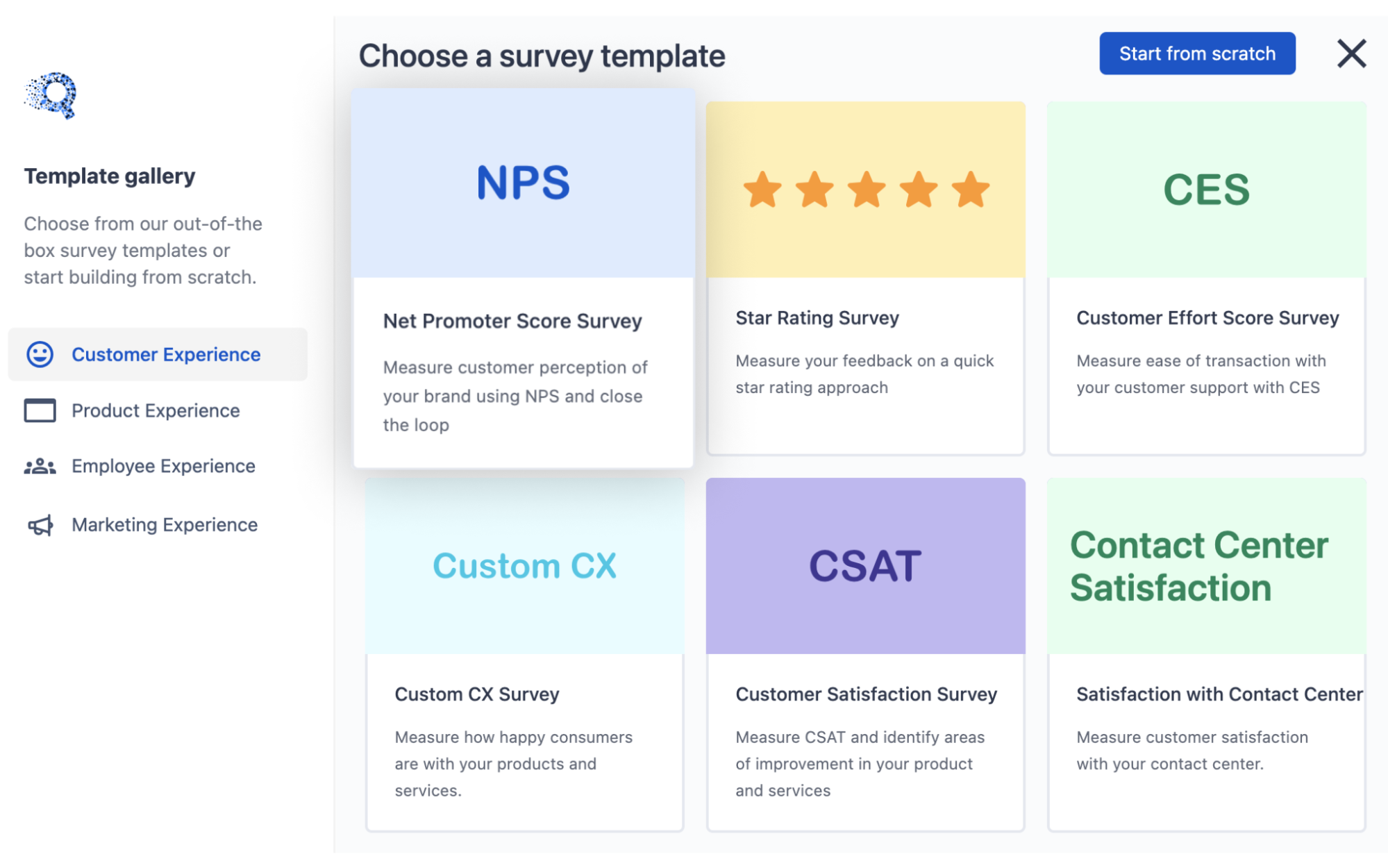
2. Text Analysis
- Delighted: With Delighted, you get the basics: scores, trends, and response breakdowns. But when it comes to understanding why customers feel the way they do? There’s no built-in capability to analyze open-ended feedback or dig deeper into themes and sentiments.
- SurveyMonkey: It gives you visually rich graphs, filters, and export options. But when customers leave detailed open-text responses, you’re left manually tagging and interpreting the,m which is time-consuming and error-prone.
- SurveySensum: This is where SurveySensum stands out. It offers AI-powered text analysis software that not only detects sentiment but also uncovers themes, emotions, and even emerging issues in customer feedback. You see what’s driving dissatisfaction — without having to dig through hundreds of comments manually.

Still tagging and reading open-ended responses manually in SurveyMonkey or Delighted? Let AI do the heavy lifting with SurveySensum’s real-time text analysis and summaries
3. CX Consultation and Support
- Delighted and SurveyMonkey: Both tools provide documentation, help centers, and community forums — but you’re largely on your own when it comes to designing the right strategy, fixing drop-offs, or interpreting results.
- SurveySensum: With SurveySensum, you get access to dedicated CX experts who guide you through every step, from choosing the right survey to interpreting insights, and even helping you close the loop. It’s like having an extra team member (minus the overhead).
4. AI Co-Pilot – sensAI
- Delighted and SurveyMonkey: Survey creation is manual — you need to know what to ask, how to structure questions, and where to route them. There’s no smart assistant to guide you through it.
- SurveySensum: SurveySensum’s built-in AI Co-Pilot – sensAI is your smartest teammate for everything customer feedback. No more dashboard digging. No more guesswork.
Just ask sensAI:
- “What’s driving negative NPS this quarter?”
- “Any new CX red flags from today’s chat logs?”
- “Which product is getting the most complaints?”
And get instant, accurate answers.
It’s not just AI. It’s your personal CX strategist, analyst, and survey designer — rolled into one smart assistant.
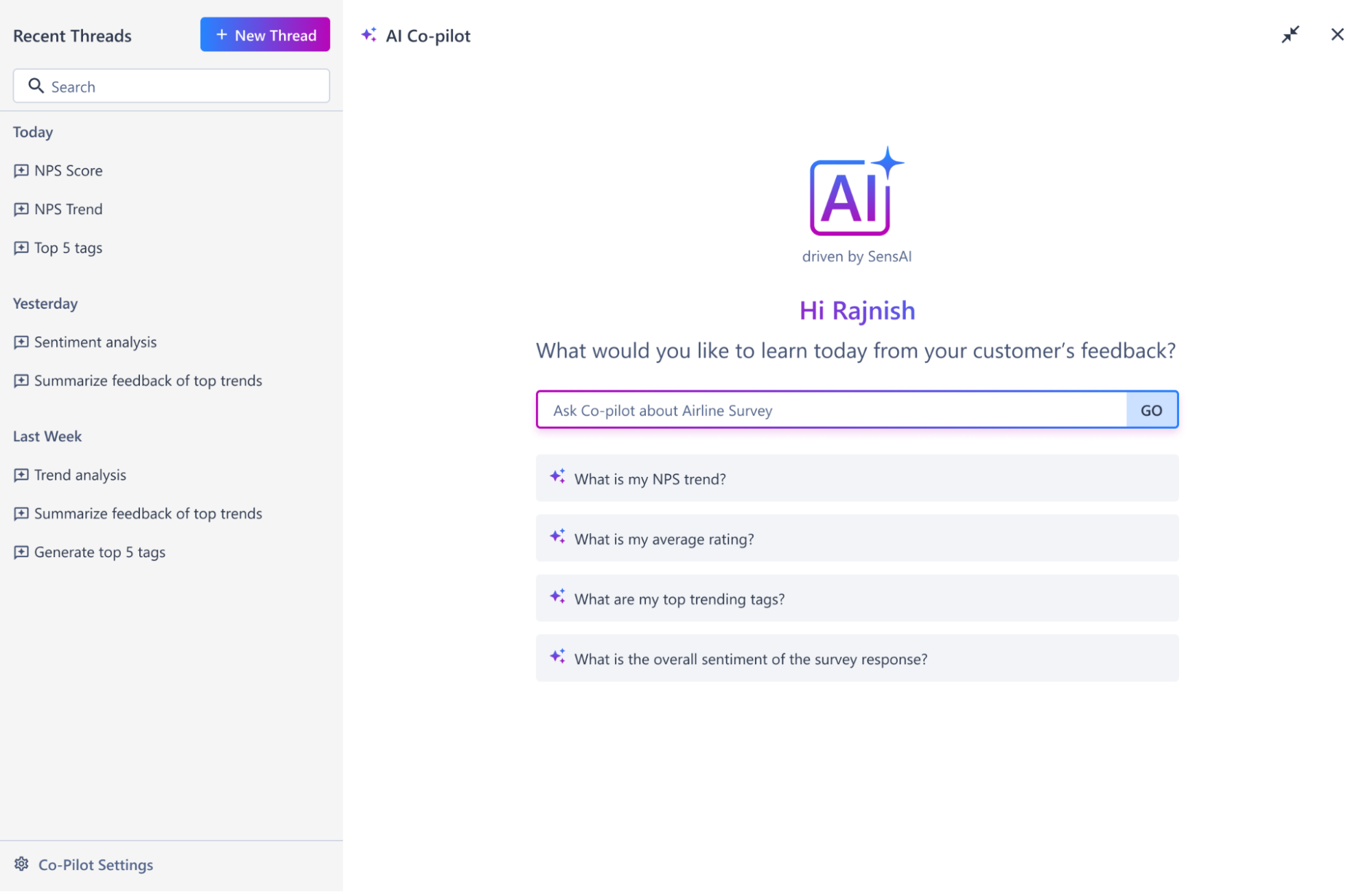
5. AI Summary of Open-Ended Responses
- Delighted: Delighted lets you collect open-text feedback, but that’s where it stops. There’s no built-in summarization, sentiment detection, or theme extraction. You’ll have to manually read through each comment, tag them one by one, and try to piece together trends
- SurveyMonkey: SurveyMonkey offers slightly more structure. You can filter responses by keywords, use basic text analysis, or export to Excel for deeper manual analysis. But there’s still no AI-based summarization. It’s mostly DIY, meaning you do the tagging, grouping, and reporting yourself.
- SurveySensum: SurveySensum truly shines when it comes to making sense of open-ended feedback. Its AI doesn’t just skim through responses; it reads every comment, detects sentiment, flags urgency, and identifies recurring themes — then turns it all into a clear, plain-English summary. So instead of reading through 1,000+ responses, wondering what’s frustrating your customers.

6. AI Questionnaires
- Delighted: With Delighted, your options are limited to basic NPS and a few follow-up text boxes. That’s it. No flexibility, no customization, no help if you want to build something more nuanced.
- SurveyMonkey: It gives you more control, but it’s all manual. You’ll spend hours browsing templates, tweaking questions, and guessing if you’ve built it right.
- SurveySensum: SurveySensum, on the other hand, brings you AI-generated questionnaires and builds surveys for you. Just describe your goal in plain English (like “I want to know if customers find our onboarding helpful”), and AI will:
-
- Ask follow-up questions to refine your intent
- Auto-generate the full questionnaire
- Add branching logic if needed
- Ensure it’s bias-free, short, and on-point
- Recommend the best survey type (CSAT, CES, NPS, etc.)
No more guesswork. Just smarter, faster, and more effective survey creation — in under 60 seconds.

7. Reporting and Dashboards
- Delighted: Offers clean and simple visualizations — enough for basic reporting. But you won’t find advanced filters, comparisons across touchpoints, or the ability to slice data by customer segments or tags.
- SurveyMonkey: SurveyMonkey’s reporting is customizable and flexible, but it can get complicated for non-technical users. You might spend more time figuring out how to set up a report than actually using it.
- SurveySensum: Delivers real-time, customizable CX dashboards with filters by location, channel, date, and more. You can automate scheduled reports, monitor key KPIs at a glance, and even export executive-ready summaries in a few clicks.
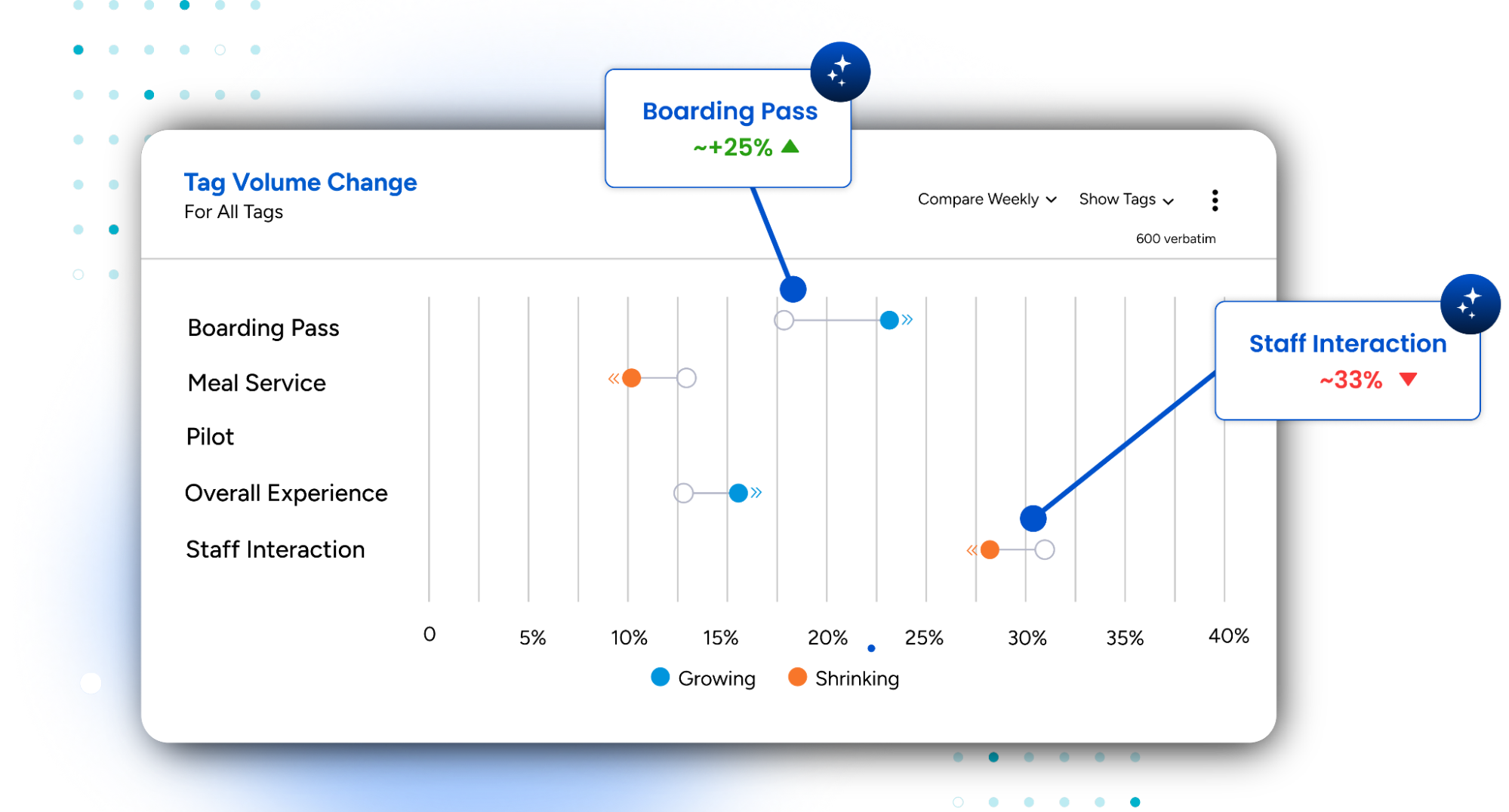
8. Real-Time Ticketing System
- Delighted and SurveyMonkey: Neither platform offers built-in ticketing. If you want to follow up on detractors or escalate issues, you’ll need to set up third-party workflows or do it manually, which delays action.
- SurveySensum: SurveySensum comes with a real-time ticketing system. Every low NPS, CSAT, or CES triggers an automatic ticket, which is routed to the right team instantly, complete with the context and sentiment of the response. It’s a game-changer for closing the loop fast.

Final Verdict: Choose Based on Your Feedback Goals
There’s no “one-size-fits-all” survey tool. Only the one that fits your current goals and future needs.
- Want something quick and basic, and only NPS? Go with Delighted.
- Need custom research or complex branching? Go with SurveyMonkey.
- Want actionable CX insights, AI automation, and real-time resolution — without the overwhelm?
Then SurveySensum is where you need to be.
It gives you the speed of Delighted + the power of SurveyMonkey — without the cost or complexity of either.
One Tool. All the Insights. None of the Hassle.
FAQs on Delighted vs SurveyMonkey
If you’re looking for a SurveyMonkey alternative that’s customer experience-focused, packed with AI capabilities, and easy to use, SurveySensum is your best bet. It offers real-time dashboards, automated text analysis, ticketing, and even dedicated CX consultation — everything you need to turn feedback into action.
SurveyMonkey is a solid general-purpose survey tool, but it falls short on CX-specific needs. It lacks real-time ticketing, AI-powered summaries, and hands-on support. Plus, analyzing open-ended responses is still a manual task which can slow you down when customer feedback is pouring in.
The Delighted + Qualtrics platform is a great fit for businesses kickstarting their CX efforts and planning to scale. For teams looking for a more agile enterprise alternative as they grow, it’s helpful to see a direct comparison, like our SurveySensum vs Qualtrics analysis.
SurveyMonkey has rebranded as Momentive for its enterprise offerings. However, the core product is still known as SurveyMonkey. The rebrand was part of its shift toward more agile experience management solutions.













